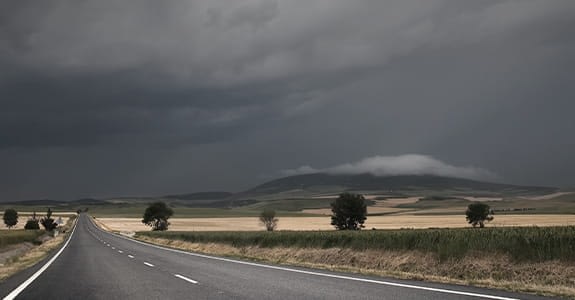As motorcyclists, we understand the call of the open road. We seek the joys of natural-world experiences and desire more than air-conditioned car rides enduring—at best—the scent of cardboard pine trees dangling from rearview mirrors.
While we welcome nature’s open-air sights and smells, there are admittedly some uncontrollable elements that we face on the road. Consider rain—its scent usually reaches our nostrils just before it hits the face shield of our helmet, leaving us with little warning.
So, what’s the best way to stay safe when it comes to riding in the rain?
Plan ahead for rain
When possible, avoid riding in the rain altogether. For longer trips, however, rain can be an unavoidable factor. Know what’s ahead by checking the weather before you hit the road. With increased access to technology, weather forecasting services, and phone apps, there’s really no reason to leave without being informed. And yes, it’s true—weather forecasters have been known to get it wrong a time or two, but predictions can increase your chances to best prepare.
For those times you’ll be riding in the rain, investing in good-quality motorcycle rain gear—from boots to pants and a jacket—can help keep you dry during your ride. Don’t forget rain gloves or mittens to protect your hands as well. Ironically, it seems that if you pack rain gear, rain doesn’t fall, but let’s not count on that.
Stay calm
The first few minutes of rain hitting the pavement can produce the greatest rain-based hazard. Why? Because all roads are covered by a fine oil film deposited by countless vehicles passing over them. As rain begins to fall, the water slides beneath the oil film, making the roads suddenly slick and dangerous. After a period of good hard rain, the layer of oil washes into the storm drains and ditches. However, a slow-misting rain can create an even more slippery mix of oil and water, like salad dressing spread across the road.
When you encounter slippery planes, it’s best to remain smooth at the controls and gently reduce your speed. Next, adjust your following distance within traffic to help avoid sudden braking or steering. Good motorcycle tires can aid you due to their rain sipes, created to move water from under the tread for better wet-weather traction. Yet it’s possible to overspend traction if you overreact. Simply put, avoid panicked inputs to the motorcycle so you can enjoy your ride, keeping yourself and others safe.
Pull over and gear up safely
When you determine it’s necessary to pull over and outfit yourself with rain gear, consider the type of road you’re on to help ensure the safest location. While overpasses along interstates and highways may appear to offer shelter from the storm, they can be dangerous. People driving automobiles have similar ideas to pull under the bridge at the same time. That, the downpour, lack of visibility, and increased stress, can be a recipe for disaster. Riding ahead to find a different location can help increase your safety.
In the cases where an underpass is your only option, remember to leave your lights, turn signal, and, if you have them, four-way flashers on. Grab your gear and move away from the road while you suit up. Then, remount the motorcycle and proceed to enter the roadway safely.
On side roads or country lanes, you often find service stations or banks with canopies that you can stop under to put on your rain gear. Places like these are often well lit and drivers typically expect other vehicles to be there. That said, it’s still important to take caution—park away from vehicle paths and leave your lights on so you’re easily seen and free to gear up without issue.
Consider terrain
Where you’re riding makes a difference in how you can prepare for potential rain. For instance, wide-open flatlands offer you greater visibility for storms in the distance. That way, if you see rain clouds in the direction you plan to ride, you have an opportunity to stop and get geared up before you reach it.
If you happen to be riding in the mountains, weather can be ruled by microclimates and rain can occur with little to no warning. In that case, you can apply the “don’t panic” plan of action and ride safely until an appropriate stopping place presents itself so you can put on your rain gear. In as little as 15 minutes, you can pass through a mountain rain and then dry out in the wind as you ride.
Rain or shine, automobile drivers simply won’t experience nature the way we do. We have the privilege to know the natural world in all its power and splendor, and a responsibility to ourselves and others, to practice safe habits.
Till next time, ride safe!
Related links
At Dairyland, we care about your safety first and foremost. Check out more motorcycle safety tips to help keep you safe on the open road.
Have any questions about your insurance coverage? Great! Our FAQ page can help. If you prefer speaking to our helpful team directly, don’t hesitate to contact your Dairyland agent—we’re here to serve you.
Article originally posted on www.dairylandinsurance.com(opens in new tab)

Dairyland® is affordable insurance that works for you.
No matter what journey you’re on, we’re all driving down the same road. And we’re here to help protect you when you need us most. For decades, customers like you have trusted Dairyland® for:
- Car insurance
- Motorcycle insurance
We offer customized coverage, money-saving discounts, flexible payment options, SR22s, and outstanding customer service.
Contact The Jemez Insurance Agency today to experience the Dairyland® difference for yourself.


